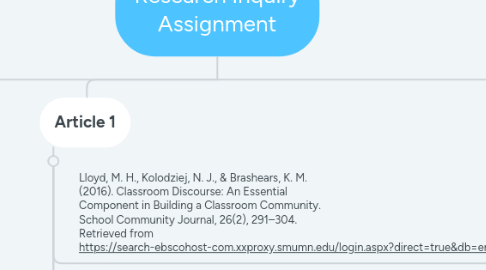
1. Article 2
1.1. Sean Kearney, W., Smith, P. A., & Maika, S. (2016). Asking students their opinions of the learning environment: an empirical analysis of elementary classroom climate. Educational Psychology in Practice, 32(3), 310–320. https://doi-org.xxproxy.smumn.edu/10.1080/02667363.2016.1173015
1.2. Classroom Climate Index
1.2.1. Survey assessing if the classroom environment plays a role in student achievement
1.2.1.1. Questions centered focused on: supportive teacher behavior, student collegial support, and student engagement in classroom activities
1.2.2. Supportive Teacher Behavior
1.2.2.1. Examples of questions: the teacher goes out of their way to help students, the teacher really cares about us, the teacher shows transparency
1.2.3. Student Collegial Support
1.2.3.1. Examples: I have many friends in my class, students get to work together a lot, It's okay for me to help other students and vice versa.
1.2.4. Student Engagement
1.2.4.1. Examples: The work we do is fun and enjoyable, there is too much boring homework, it's easy to focus on what the teacher is saying
1.2.5. Results
1.2.5.1. Compared validity of survey with the MCI (My Classroom Index) evaluating satisfaction of students with their educational environment
1.2.5.1.1. Found a strong positive correlation in all 3 areas of the CCI with factors of satisfaction and cohesion in the MCI
1.3. Key concept: Connectedness
1.3.1. Encourage students to ask their classmates when they need help with schoolwork
1.3.2. Provide opportunities to share out-of-school activities to grow relationships amongst peers
1.3.2.1. As the teacher, ask genuine questions about the activities or attend after school activities if possible to show you care
1.3.3. When designing lessons, think about how your students would like to learn the concept and plan accordingly
2. Article 1
2.1. Lloyd, M. H., Kolodziej, N. J., & Brashears, K. M. (2016). Classroom Discourse: An Essential Component in Building a Classroom Community. School Community Journal, 26(2), 291–304. Retrieved from https://search-ebscohost-com.xxproxy.smumn.edu/login.aspx?direct=true&db=eric&AN=EJ1124019&site=eds-live
2.2. Discourse as a community builder
2.2.1. Using the FLE (facilitate-listen-engage) model where the teacher facilitates discussion instead of the IRE (initiate-respond-evaluate) model where the teacher gives information and assesses based on responses
2.2.2. FLE (facilitate-listen-engage)
2.2.2.1. Student focused rather than teacher focused
2.2.2.1.1. Students discuss their learning with their classmates while the teacher steps in when needed to ask questions or clarify
2.2.3. IRE (initiate-respond-evaluate)
2.2.3.1. Teacher focused
2.2.3.1.1. Teacher lectures, students listen
2.2.3.1.2. Students respond to the lecture in the form of an assessment
2.2.3.1.3. Teacher evaluates the response
2.2.3.1.4. Creates a culture of respect the teacher as an authoritarian rather than a facilitator
2.3. Key concept: Communication
2.3.1. Pair share
2.3.1.1. Allow students to share their thinking throughout the day
2.3.1.2. Provides more opportunities for students to interact with each other
2.3.2. Small group work
2.3.2.1. Design lessons where students can work in triads or quads so they can practice working with other people
3. Interview
3.1. Jon Klippenes, my current principal who has experience as a 5th grade teacher
3.1.1. Community is a group of people that interact with each other whether living with or near each other or working together
3.1.1.1. Built on trust where everyone is looking out for the best interests of each other
3.1.1.2. Does not mean that everyone always agrees and sees eye-to-eye
3.1.1.2.1. Differing strengths and opinions makes the community stronger in spite of differences
3.1.1.3. In the classroom, students need to feel a part of the group
3.1.1.3.1. Classroom jobs
3.1.1.3.2. Choice
3.1.1.3.3. Clear expectations and roles
3.1.1.4. Community can be reached but is never stagnant
3.1.1.4.1. Should always be revisited or revamped as the school year progresses
3.2. Key concept: Teamwork
3.2.1. Work with your students to design classroom rules that they agree to
3.2.2. Assign rotating classroom jobs to make students feel important and included
3.2.3. Find specific times to allow students to interact with classmates they do not normally associate with
3.2.4. Be intentional in creating activities where students work together to complete a task
3.2.4.1. Model positive partner behavior
